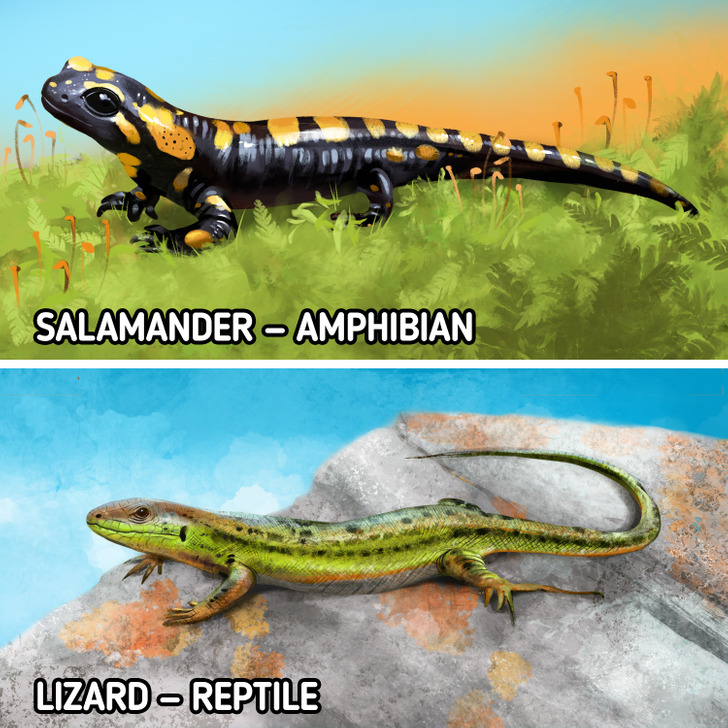The Difference Between Amphibians and Reptiles
Amphibians and reptiles are 2 classes of animals that many people confuse. It’s sometimes quite hard to understand which animal is which.
5-Minute Crafts is going to help you learn the difference between amphibians and reptiles.
The similarities between amphibians and reptiles
There are several important similarities between amphibians and reptiles that might confuse you:
- Thermoregulation
Both amphibians and reptiles are ectotherms or ectothermic animals. The temperature of their bodies depends on the temperature of the environment. For example, if it’s hot, their body temperature rises. They can’t regulate their own body temperature. - The oldest species
Both reptiles and amphibians originated over 300 million years ago, which makes them some of the oldest species on Earth. - Defense
Neither reptiles nor amphibians have a powerful defense mechanism. They try to avoid predators using camouflage. Even though some of them can inflate their bodies or use toxins, these methods are their last resort.
The difference between amphibians and reptiles
Skin
- Amphibians have smooth, thin, transparent skin, allowing them to breathe not only on land but also in water. Many of them have warts with different functions and mucous glands that generate mucus, which help to moisten an amphibian’s skin and keep it from drying out. Amphibians, like reptiles, can shed old skin. Some of them even eat it.
- The skin of reptiles is covered in scales, like turtles. It’s watertight and plays a huge role in their protection. Unlike amphibians, reptiles can’t secrete mucus through their skin. Many of them shed old skin over the course of their entire lives.
Habitat
- Amphibians can live on both land and in water. But still, many of them spend most of the time in the water or near it. Also, most amphibians have a water stage in their life cycle, like tadpoles with frogs and toads.
- Most reptiles spend a big part of their lives on land. Even though they can swim and spend time in the water, very few live in it or next to it. Even crocodiles, who spend a lot of time in water, rest on land.
Offspring
- Even though most amphibians and reptiles lay eggs, the eggs are very different. Amphibian eggs appear gelatinous and contain various mucous compounds. The outer layer is permeable to water and gas and can absorb large amounts of water. The fertilization is external, and the babies develop outside the parents’ bodies.
- Reptiles have internal fertilization. They lay amniotic eggs covered by a leathery or calcareous shell.
- Some amphibians and reptiles give birth to live young, such as fire salamanders and garter snakes.

Respiration
- Amphibians have quite primitive lungs that let them breathe when they are on land. Some types of amphibians, like tadpoles, use gills. Their skin is also a respiratory organ.
- Reptiles can’t breathe through their skin — all of them use lungs. But some reptiles, such as turtles, evolved to have more permeable skin that allows for limited gas exchange through their cloaca.
Tongue
- Most amphibians have a sticky whole tongue that helps them get food.
- Most reptiles have a bifurcated tongue that acts as a sense organ. It lets the animal smell things and find its prey. But some reptiles rely on whole sticky tongues, like chameleons. They secrete mucous that helps them hunt.
Eyes
- The eyes of amphibians allow them to see well both on land and underwater. Amphibians have narrow spectrum visibility, which means they have less efficient light detection and can only see a limited number of colors.
- The eyes of reptiles are more developed and can see a broader spectrum of colors, but they don’t see as well underwater.
Larva
- The life cycle of most amphibians starts with an aquatic larval stage. During this stage, they develop the main organs they need to survive adulthood. The process of larvae turning into an adult is called metamorphosis.
- Unlike amphibians, reptiles don’t have the larva stage, and they don’t have metamorphosis. They either lay eggs or give birth to live babies that look like miniature copies of adults.
Which creatures are amphibians and which are reptiles
Amphibians have 3 orders: order Anura includes toads and frogs, order Caudata includes salamanders and newts, and order Apoda includes caecilians.
Reptiles include 4 orders: order Squamata includes lizards and snakes, order Crocodilia includes crocodiles and alligators, order Testudines includes turtles and tortoises, and order Sphenodonta includes tuatara.
Share This Article